Top things to do in Vietnam: Ideas to make the most of your trip
Wondering what are the best things to do in Vietnam? Discover the best activities for your trip, from the cave systems in Phong Nha-Ke Bang to the floating markets and rice terraces of the Mekong Delta.
Kite-surfing in Mui Ne, cruising the Mekong Delta, exploring UNESCO World Heritage sites like Hoi An and My Son Sanctuary — there’s a lot that Vietnam has to offer. And with so many options, where do you even begin?
This guide features 11 of our top picks — some popular, some under the radar — so you can experience Vietnam to the fullest and avoid the dreaded FOMO.
Explore Vietnam’s natural wonders
Vietnam is full of amazing natural sights — limestone mountains, cave systems, and more. Here are two that you shouldn’t miss, and don’t forget to get mobile internet in Vietnam before each adventure.
Ha Long Bay
You must have heard a lot about Ha Long Bay — the UNESCO World Heritage Site that’s popular for its limestone karsts, emerald waters, and hidden caves. And though it’s a tourist hotspot, the breathtaking scenery is worth wading through a crowd of people.
However, if you’d prefer something more secluded, the nearby Bai Tu Long Bay and Lan Ha Bay are great places to visit. There’s also Tam Coc in Ninh Binh — often called “Halong Bay on Land” due to its equally stunning limestone karsts.
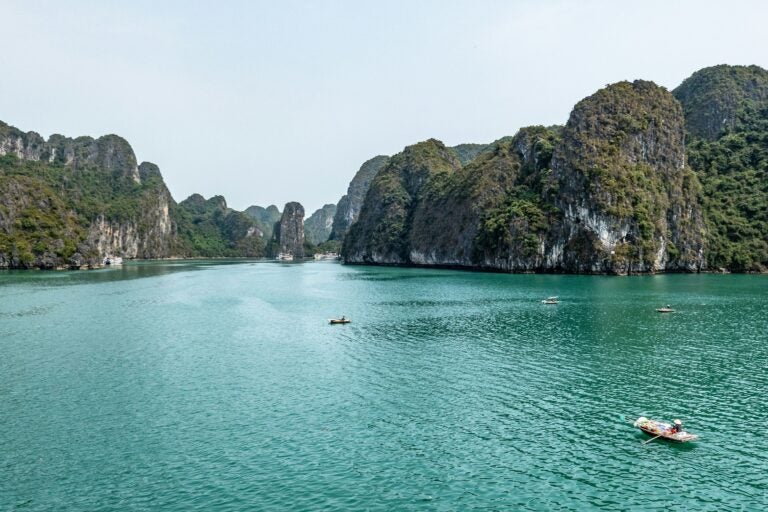
Top activities
- Explore Ha Long Bay on a cruise. They offer both day and overnight cruises, which are a great way to see the bay’s landscapes and lagoons up close. Many cruises even include kayaking in their itinerary.
- Visit Sung Sot Cave and Dau Go Cave — both have multiple chambers filled with super impressive stalactite and stalagmite formations.
- Book a guided boat tour and visit the nearby Cat Ba island or traditional floating villages like Cua Van, Vung Vieng, and Cong Dam.
How to get there: Fly into Hai Phong, then take a bus or taxi to Ha Long Bay (40 miles).
Phong Nha-Ke Bang National Park
Another place known for its natural splendor is the Phong Nha-Ke Bang National Park. The karst mountains are some of the oldest in Asia — they’re said to be 400 million years old.
It also has one of the most intricate cave systems in the world, including dry, terraced, and intersecting caves.
Two tips for visiting the national park: go during the dry season (March to August), and book your accommodation at one of the many farmstays in Phong Nha for an authentic Vietnam countryside experience.
If you’re vegan, try the Veggie Box for lunch. They’ve got some really good vegetarian variations of popular Vietnamese dishes. And for farm-to-table dining, you can’t do better than Chay Lap Farmstay.
Top activities
- Take a guided caving tour and explore some of the biggest cave systems, like Song Doong Cave (which has the largest cave passage in the world), and Paradise Cave (it’s one of the largest dry caves in Asia).
- Go on a multi-day trek through remote caves like Hang En or Tu Lan. Camp under the stars and cool off with long swims along the way.
- Take a guided birdwatching tour or take a walk by one of the many streams in the park during the early morning hours. The park is home to over 300 species of bird, like the Asian hornbill and red-shanked douc langur.
- Take a mudbath in Toi Cave (Dark Cave), near Chay River.
How to get there: Take a flight or train to Dong Hoi. From there, you can take a local bus or taxi to the Phong Nha-Ke Bang National Park (27 miles).
Discover Vietnam’s historical and cultural sites
Vietnam’s landmarks — ancient temples, war memorials, and more — are a great way to explore its political, historical, and spiritual heritage. So add some of these sites to your Vietnam itinerary.
Hanoi Old Quarter
If you’re looking to experience Vietnam at its most authentic, the Hanoi Old Quarter 36 streets — where the past blends so beautifully with the present — is a must-visit.
If you want to go on a shopping spree, check out these three streets:
- Hang Bac for silver jewelry
- Hang Gai for fabric and custom-made suits
- Lan Ong for traditional medicine and herbs
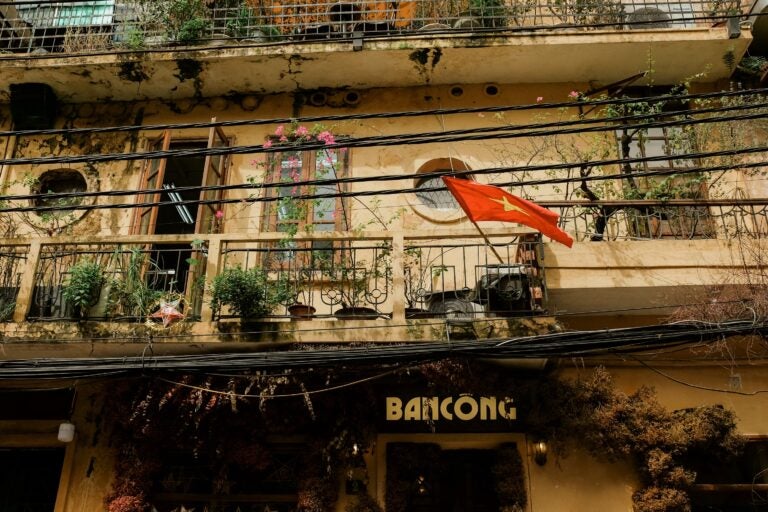
Top activities
- Explore historic landmarks like the Turtle Tower and Ngoc Son Temple — they’re both free to visit.
- Go to the Thang Long Water Puppet Theatre to enjoy performances on Vietnamese mythology.
- Sample local specialties such as Vietnamese egg coffee, banh mi (Vietnamese sandwich), and bun cha (grilled pork with noodles).
How to get there: Fly to the Noi Bai International Airport in Hanoi or take a train to the Hanoi Railway Station. Once in Hanoi, you can take a local bus or taxi to the Old Quarter.
Cu Chi Tunnels
If you’re visiting Southern Vietnam, then Cu Chi Tunnels — though touristy — are another must-visit. It’s a reminder of Vietnam’s dark history during the Vietnam War, and the ingenuity of the Viet Cong’s guerilla warfare tactics.
For international tourists, there’s an entrance fee that ranges between $25–$30.
Keep in mind that some sections of the tunnel are narrow and low, and you’ll need to crawl through them. If you’re claustrophobic or have breathing problems, we suggest skipping them.
Top activities
- Book a half-day tour and explore the Cu Chi Tunnel complex.
- Check out the three reenactment areas to see how the Viet Cong soldiers lived and worked within the confined spaces of the tunnels.
- For just $2, fire real weapons such as AK-47s or M16s that were used during the war.
How to get there: Fly to Ho Chi Minh City. Then take a taxi or public bus to Cu Chi Tunnels (27 miles).
My Son Sanctuary
My Son Sanctuary in the Quang Nam Province is a temple complex that’s older than even Angkor Wat.
It’s a cluster of abandoned and partially ruined Hindu temples built between the 4th and 13th centuries by the Champa Kingdom.
The sanctuary is open from 6:00 AM to 5:00 PM, and the entrance fee is around $6.

Top activities
- Explore the temple ruins — Groups B, C, and D are the best-preserved sections.
- Visit the nearby My Son Sanctuary Museum to learn about the Champa civilization.
- Watch a live Apsara dance performance. It usually happens at 9:00 AM.
How to get there: Fly into Da Nang International Airport or take a train to Hoi An, and then take a bus or taxi to the My Son Sanctuary (25 miles).
Enjoy Vietnam’s vibrant city life
Looking to mix things up? These two places are the best for experiencing Vietnam’s city life.
Ho Chi Minh City (Saigon)
Ho Chi Minh City, formerly known as Saigon, is the largest city in South Vietnam, which makes it the best place to experience the frenetic pace of Vietnam’s urban life. Depending on what you want to do, here are the neighborhoods to visit:
- Dong Koi in District One for luxury boutiques and high-end restaurants, and Bui Vien Walking Street for nightclubs and bars. When there, try the home-cooked Vietnamese food or draught beers like bia hoi at the Michelin-starred Rice Field Restaurant.
- Thao Dien in District Two for the art scene. It’s popular with digital nomads and expats and has plenty of organic and vegan restaurants.
- District Three for heritage sites and learning about Vietnamese history. When here, don’t miss the 80-year-old Pho Dau restaurant, one of the oldest and most authentic pho diners in Vietnam.
And if you have a few days to spare, take a one-day trip to Tay Ninh, the birthplace of the Cao Dai religion — a syncretic religion that considers Joan of Arc and French novelist Victor Hugo as two of its saints.
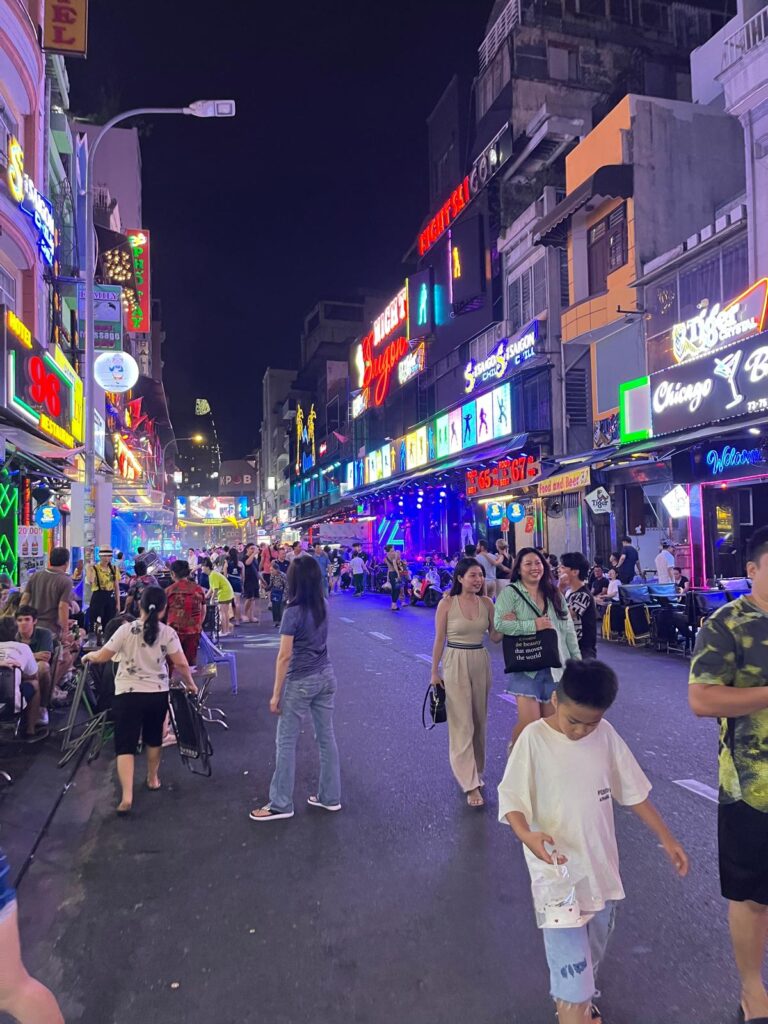
Top activities
- Go shopping at Ben Thanh Market, one of the oldest markets in Ho Chi Minh City.
- Visit the Chinese Quarter (Cho Lon). You can explore the Binh Tay Market and enjoy authentic Chinese cuisine at the many food stalls.
- Check out the various attractions like the Notre Dame Cathedral, War Remnants Museum, and Giac Lam Pagoda.
How to get there: Fly into the Tan Son Nhat International Airport in Ho Chi Minh City or take a train to the Saigon Railway Station.
Hoi An Ancient Town
The Hoi An Ancient Town is a UNESCO World Heritage Site located in central Vietnam. It’s also got plenty of historical and cultural sites.
But what makes Hoi An truly stand out is its hidden pockets of authenticity. Like playing a game of Bai Choi (a Vietnamese card game) at the Hoi An Bridge every night or getting custom-stitched silk ao dais from local tailors.
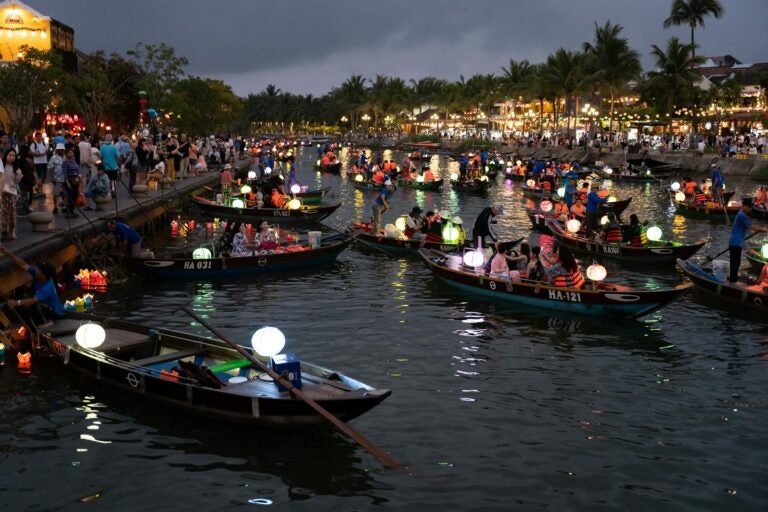
Top activities
- Purchase an Old Town ticket ($5) and visit historic sites like Tan Ky House, Phuc Kien Assembly Hall, the Japanese Covered Bridge, and The Museum of Trade Ceramics.
- Rent one of Vietnam’s traditional bamboo boats and cruise through the canals of the Cam Thanh Coconut Forest.
- Buy silk fabrics and tapestries at the Hoi An Cloth Market or Hoi An Silk Village, and have them made into custom clothing by a local tailor.
- Join a cooking class to learn how to prepare different dishes like cao lau (a local noodle dish) or banh mi (a Vietnamese sandwich).
How to get there: Hoi An is located about 18 miles south of Da Nang. Take a flight or train to Da Nang and then a bus or cab to Hoi An.
Discover unique experiences in Vietnam
Looking for only-in-Vietnam, Instagram-worthy places to go to? Go here:
Mekong Delta
The Mekong Delta, also known as the Nine Dragon River Delta, is around 40,000 square kilometers and includes 12 provinces. What you see and do depends on the region you visit. Here are some key provinces to visit:
- Ben Tre to visit coconut plantations and taste the most delicious coconut candies
- Dong Thap to explore natural reserves and go on nature walks or birdwatching tours
- An Gieng to walk through acres of terraced rice fields and explore Vietnam’s agricultural heritage
Top attractions
- Check out the floating markets where locals sell fresh produce and handicrafts from their boats. Popular ones are Cai Rang (3.7 miles from Can Tho City) and Cai Be (43 miles from Can Tho City.
- Explore national parks like Tra Su Cajuput Forest or U Minh Ha National Park. They’re both great places for nature photography and birdwatching.
- Book a boat tour to explore the many fishing villages, mangrove forests, and islands in the Delta.
How to get there: Fly to Ho Chi Minh City and then take a bus or taxi to the Mekong Delta.
Mui Ne Sand Dunes
Located near the coastal town of Phan Thiet, the Mui Ne dunes are one of the most otherworldly natural attractions in Vietnam. There are two main types of dunes:
- The red dunes (doi hong), close to the city of Mui Ne
- The white dunes (doi cat trang), 14 miles northeast
For the best experience, we suggest visiting the dunes in the early morning hours. It’s quiet, and the sands are largely untouched, making for great photographs.
As the dunes can get super hot during the day, make sure to add some sunscreen and a hat to your Vietnam packing list.

Top activities
- Rent a quad bike (around $20 for 30 minutes) and explore the sand dunes by yourself.
- Go sandboarding down the slopes of both the White and Red Sand Dunes.
- Check out the lotuses in full bloom at Lotus Lake if you’re traveling between late May and early September.
How to get there: Fly into Ho Chi Minh City and then take a bus or taxi to Mui Ne (125 miles).
Experience adventure and outdoor activities
If you’re an adrenaline junkie, here are two ways you can get your heart rate pounding when you visit Vietnam.
Motorbiking from North to South
One of the best ways to explore Vietnam, particularly if you want to visit sites off the beaten path, is by motorbike.
Vietnam has some of the best (and most scenic) motorbiking roads in the world. The most popular route starts in Hanoi and ends in Ho Chi Minh City (1,700 miles and 3–4 weeks).
Note that it’s illegal for tourists to buy a motorbike in Vietnam. So rent from a reputable company. Most allow test drives and it’s a great way to check out the condition of the bike.
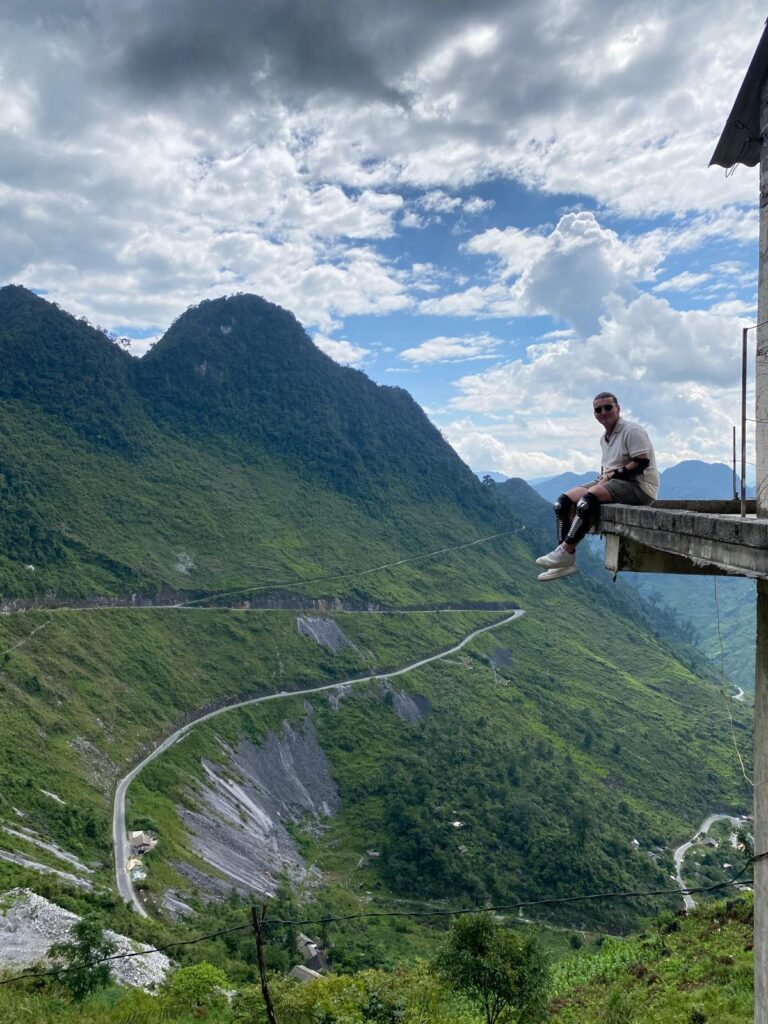
Best motorbike routes
- Hai Van Pass: It’s located between Hue and Da Nang, is 12 miles long, and has the most striking scenery.
- Khe Sanh to Phong Nha: This 124-mile route takes you through the Truong Son Mountains and Ho Chi Minh trail.
- O Qui Ho Pass: It runs through the Hoang Lien Son Mountains (31 miles) and is quite narrow, with steep inclines and sharp turns.
- Ha Giang Loop: At 239 miles, it’s one of the best routes to explore Northern Vietnam and takes around 3–7 days to complete.
Price: Daily rental rates range from $4–$30 depending on the type and condition of the motorbike. Many rental shops also offer discounts for longer periods.
Kite-surfing in Mui Ne
Mui Ne is not just known for its stunning dunes but also for its beautiful beaches — making it one of the most popular kite-surfing destinations in Southeast Asia.
The most popular spot for kite-surfing in Mui Ne is Rang Beach, but beginners can try Kite Beach for a less crowded and safer experience.
Experienced surfers, on the other hand, should check out Hon Rom. It’s got the strongest winds and the largest waves. For the best wind conditions, plan your trip for the Northeast wind season (November to April).
How to get there: Fly into Ho Chi Minh City and then take a bus or taxi to Mui Ne (125 miles).
Cost: A two-hour session with all equipment would cost around $60.
Add the Holafly Vietnam eSIM to your packing list
Make sure to purchase a mobile internet plan. You’ll definitely need GPS to get around — especially if you plan to tour parts of Vietnam on a motorbike.
Public WiFi is only available in hotels, so you’ll do well with either Vietnam SIM card or pocket WiFi. Both Viettal and Vinaphone have good coverage. And if you’d rather not hunt down a local SIM card provider on arriving in Vietnam, then we suggest trying a Vietnam eSIM.
Top providers for eSIMs for Vietnam — Holafly, for example — give you unlimited data in Vietnam for just $6.90 for one day. Planning a longer stay?
Your Holafly eSIM will only get cheaper as your trip extends. For a 10-day plan, you’ll pay only $3.69 per day. It’s pretty easy to set up — activate your eSIM by simply scanning a QR code and top up your plan on the Holafly app.
Purchase a Holafly eSIM for Vietnam before your next trip, and stay connected on the go!





 Language
Language 


















 No results found
No results found






